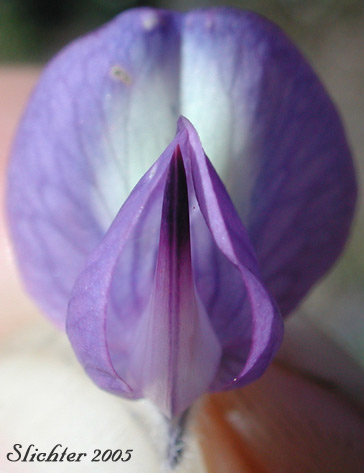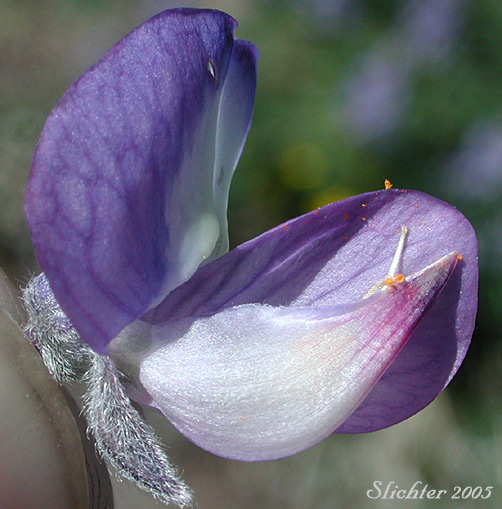 The photo at right shows a close-up frontal view of silky lupine
as seen along the Highline Trail #114, Mt. Adams Wilderness..........July 24, 2005. Note the
white center to the banner.
The photo at right shows a close-up frontal view of silky lupine
as seen along the Highline Trail #114, Mt. Adams Wilderness..........July 24, 2005. Note the
white center to the banner.Silky lupine is an attractive perennial which might be useful for natural gardens in the drier habitats of the Pacific Northwest. The one to several erect stems rise from 20-50 cm high. They are usually unbranched or perhaps with several branches to the stem. The herbage is usually somewhat silvery or rust-colo,re srom the numerous spreading to appressed hairs on the leaves and stems. The herbage is not however, as dense and silvery as that found in velvet lupine which may grow in the same habitats. The hairs are of two lengths. The leaves are mainlyon the stems (espeically at blooming times) with the lower petioles as much as 3 times longer than the leaf blades. The leaves become reduce on the upper stems with the petioles roughly the same length as the blades. The leaves are palmately-compound with 7-9 oblanceolate leaflets, each 3-6 cm long and 3-6 mm wide.
The inflorescence is an elongate raceme of numerous, fairly densely clustered flowers. The racemes vary in length from 10-15 cm long. The flowers are largely a soft blue with a lavendar tinge with 2 white markings on the banner petal. The flowers may occasionally be yellowish or whitish. The back of the banner is sparsely to densely haired with microscopic hairs. The calyx is silky with a deeply split calyx. The uper lobe is bidentated while the lower is entire. The banner is well reflexed from the keel with an index from 14-25. The keel has ciliate hairs along much of its uper edge. The tip of the keel turns upwards slightly. The pods are silky, ranging in length from 2-3 cm long and about 1 cm wide. They contain 3-5 seeds.
Silky lupine may be found on well drained soils on canyon slopes, ridges from the lowlands to well up in the mountains. It is most typically found on grasslands but may also be found in climax ponderosa pine amongst bunchgrasses.
Silky lupine maybe found from British Columbia south to the east of the Cascade Mts. to California and east to Alberta and New Mexico, with the eastern range in the US occurring in the Rocky Mts.
In the Columbia River Gorge, it has historically been collected and found along the Columbia River at low elevation from as far west as Bridal Veil and more commonly east of Hood River, OR and eastward toward Umatilla, OR. Much of what has previously been reported as silky lupine in the east end of the gorge may instead be a hybrid between silky lupine and velvet lupine.
